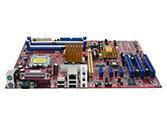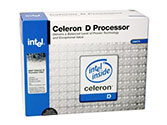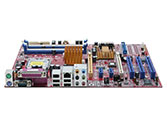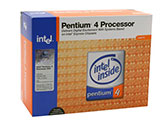Entry Level Buyer’s Guide, July 2005
by Jarred Walton on July 20, 2005 12:05 AM EST- Posted in
- Guides
Intel Recommendations
Not a whole lot has changed in the budget Intel market. Intel has had PCIe graphics for a while now, and we're still waiting for newer Celeron and Pentium chips with 64-bit support. (We're also waiting for Semprons with 64-bit support, though really we're not too concerned about the 64-bit factor for budget systems.)  |
 |
| Click images to enlarge. | |
Budget 775 Motherboard: Biostar I915P-A7
Price: $79 shipped
Budget 775 CPU: Intel Celeron D 330J 2.66GHz 256K L2 (Retail)
Price: $85 shipped (Retail)
Total: $164
Almost exactly matching the budget AMD setup in price, we continue with similar recommendations to our last budget Guide. The choice of CPU is less about performance than price, but the difference between the 2.53 GHz 325 and the 2.66 GHz 330J is only $4, so we go with the upgraded processor. You can see the complete list of Celeron prices on our Price Engine, and the next model up from the 330J adds $15, which is more than we're willing to pay for a budget setup.
The motherboard choice is the cheapest 775 motherboard that we could find with a few qualifications. First, it needs to be a PCI Express board, which generally means the 915P or 915G chipset. We avoid the 915GV chipset as that reduces performance by only supporting single-channel memory. The other requirement is that the board needs to have 4 DIMM slots of the same type, and for now, that means DDR. Some people may not mind the hybrid boards, but we like to have the ability to run 4x512MB of RAM in the future. The Biostar I915P-A7 fits all of those requirements and comes in substantially cheaper than most other competitors. Biostar also offers the I915G-M7 for those who want integrated graphics - as a business solution or a standby until you can add in a decent graphics card, the extra $6 is a good deal.
The only other boards that are priced similarly are from Jetway (915PCP/GCP), ECS (915G-M), Foxconn (915G7MC-S), and Aopen (i915Pa-E) - we may have missed one or two boards, but the point is that there aren't any name brands like ASUS or MSI in this price range. None of these are really better than the Biostar in our opinion, and they all cost a bit more.
If you like the idea of integrated graphics but want more performance, the ASUS P5RD1-V uses the ATI Xpress 200 chipset and may be worth consideration. The price of $100 makes it a moderately expensive upgrade, and if you're looking at an IGP solution you probably don't care much that the Xpress 200 is twice as fast in several gaming benchmarks - a discrete graphics card will still outperform the IGP with relative ease. As with the MSI Xpress 200 board for AMD, we don't expect much in the way of overclocking due to the chipset. Overclockers should probably look to the more recognized enthusiast brands like ASUS, DFI, MSI, etc. and get an Intel chipset, though you'll also have to pay over $100 for those.
 |
 |
| Click images to enlarge. | |
Upgraded 775 Motherboard: Biostar I945P-A7
Price: $98 shipped
Upgraded 775 CPU: Intel Pentium 505 533 FSB (Retail)
Price: $134 shipped (Retail)
Total: $232
Our upgraded Intel platform takes a bit different approach than the past. Price is once again equal to the AMD side of things, but we spend more on the motherboard and less on the CPU. We cut the CPU from the Pentium 520 of previous Guides (2.8 GHz 800FSB with HyperThreading) to the 505 (2.66 GHz 533FSB and no HyperThreading). HTT is sort of interesting, but the extra $40 to upgrade to the 520 is pretty significant. Actually, the 530J is only a couple of dollars more than the 520, so if you do go for the faster processor, the 530J is the better buy. Performance of the 505 is reasonable, though clearly outclassed by the Athlon 64 processors. Part of the reason why we like the 505 is that you can get some great overclocking results from it on virtually any motherboard. The processor has a 20X multiplier, so combined with a bus speed of 166 to 200, you can shoot for 3.33 GHz to 4.0 GHz. The upper end of that range may be difficult to reach, but 3.4 to 3.6 GHz is pretty reasonable for the 90nm Prescott design.
Along with the switch to a slightly slower CPU, we've included the cheapest DDR2 board that we could find for future compatibility, and it also uses the new 945P chipset. The switch to DDR2 will increase the price slightly relative to DDR, but even AMD will be moving to DDR2 early next year, so you should be able to use the RAM in a future system. Integrated graphics versions of the chipset are also available with the 945G series, with the most affordable options coming from ASUS (P5LD2-VM) and Intel themselves. The cheapest 945G models are micro ATX form factors, allowing the use of a smaller case like the Aspire X- QPack that we recently reviewed, as well as any other uATX case. (You can always put the small motherboard in a full-size ATX case if you prefer.)
The 945 chipsets all support dual core CPUs, providing another future upgrade path. With the cheapest Pentium D starting at well over $200, we can't recommend such a CPU for a budget system yet, but we expect prices to drop over the coming year, making it a viable upgrade in 2006. If you go with the budget Intel recommendation, you're stuck with single core processor support for as long as you own the system. Of course, some people never upgrade individual components and prefer to replace the entire system every few years. If that describes your purchasing habits, there's not much point in buying more future-proof components.










57 Comments
View All Comments
bob661 - Wednesday, July 20, 2005 - link
#25Do you remember the cost difference?
Zebo - Wednesday, July 20, 2005 - link
"I once calculated the cost of running a 60W lightbulb 24/7 for a year and it was only about $37 - 526 kWHrs at 7 cents per kWHr. "=====================
Was this after your Dad told you to turn off the lights..he's not made of money? I did the same thing.:)
BTW I calculated X2 4200+ is cheaper than 820D dispite costing $250 more up front using the same formula (although I pay 14 cents per kWHr).
Zebo - Wednesday, July 20, 2005 - link
4/10 BTW which last time I checked was an "F".. as in Failure...as in Fu**ed up.Zebo - Wednesday, July 20, 2005 - link
LOL @ suggesting Dell. They have a 4 reseller rating for a reason ya know. They suck. Add in the fact you must get rebates, must get a "hot deal" to relise any savings you're much better off BYO normally.Zebo - Wednesday, July 20, 2005 - link
Nice to see those back and very good job Jarred.Of course I have issue with 1G of ram for a "value"setup.. Any video card with a one. And all should have LCD these days... simply not that much more, $50, for both more view area in 17" and much much better quality than any POS low end CRT.
KayKay - Wednesday, July 20, 2005 - link
Good Choice on the MSI Neo4-FAbecedaria - Wednesday, July 20, 2005 - link
For your Intel setup, I would think that a 2.4C (either on eBay or retail) would perform better than any of the options you mentioned for considerably less money. And you'd get 800FSB. And you'd get HT. Granted, the legacy socket 478 and AGP are going to limitations long term, but if you were going to go for better performance, you'd want to upgrade your video card and MB anyhow.abc
bob661 - Wednesday, July 20, 2005 - link
#18You were most likely CPU limited with that 6600GT in that system. A 9800 Pro wouldn't be.
bupkus - Wednesday, July 20, 2005 - link
I tried a 6600GT in my old system-- a Barton OC'd to 2.2GHz --and it didn't perform as well as my nephew's 9800 Pro on a Barton w/ a 333 fsb and mem, so I returned it.This Venice seems to perform pretty good without any tweaks. I'm using cheap of-the-shelf PNY 2x512 PC2700 DDR at all default settings. 2T, etc.
SDA - Wednesday, July 20, 2005 - link
>> I still feel like I keep repeating myself from Guide to Guide, but maybe you readers don't notice it as much? :)>>It's a good idea to repeat important points. You'll have no trouble remembering the recommendations you made in the last few guides, but what about readers that just look at the latest guide or forgot what earlier ones said once or twice on one page?
wrt the PSU, these systems will probably eat as much power as a couple incandescent lightbulbs, but that doesn't mean a Fortron or something isn't worth the money for an upgrade. At the very least, a better PSU is pretty much guaranteed to last longer (better elcaps, fans, etc.). Remember, there are some components in rock-bottom generics that will die even if you only draw about ten or twenty watts from the things for their entire lifetimes.
>>Anyway, I don't generally worry much about the mail-in rebate opportunities, as it's basically loaning a company your money at 0% interest for several months.>>
heh.. that's a great way of putting it. Shame that most people won't get it (how many times have you seen someone brag about a large tax refund?).